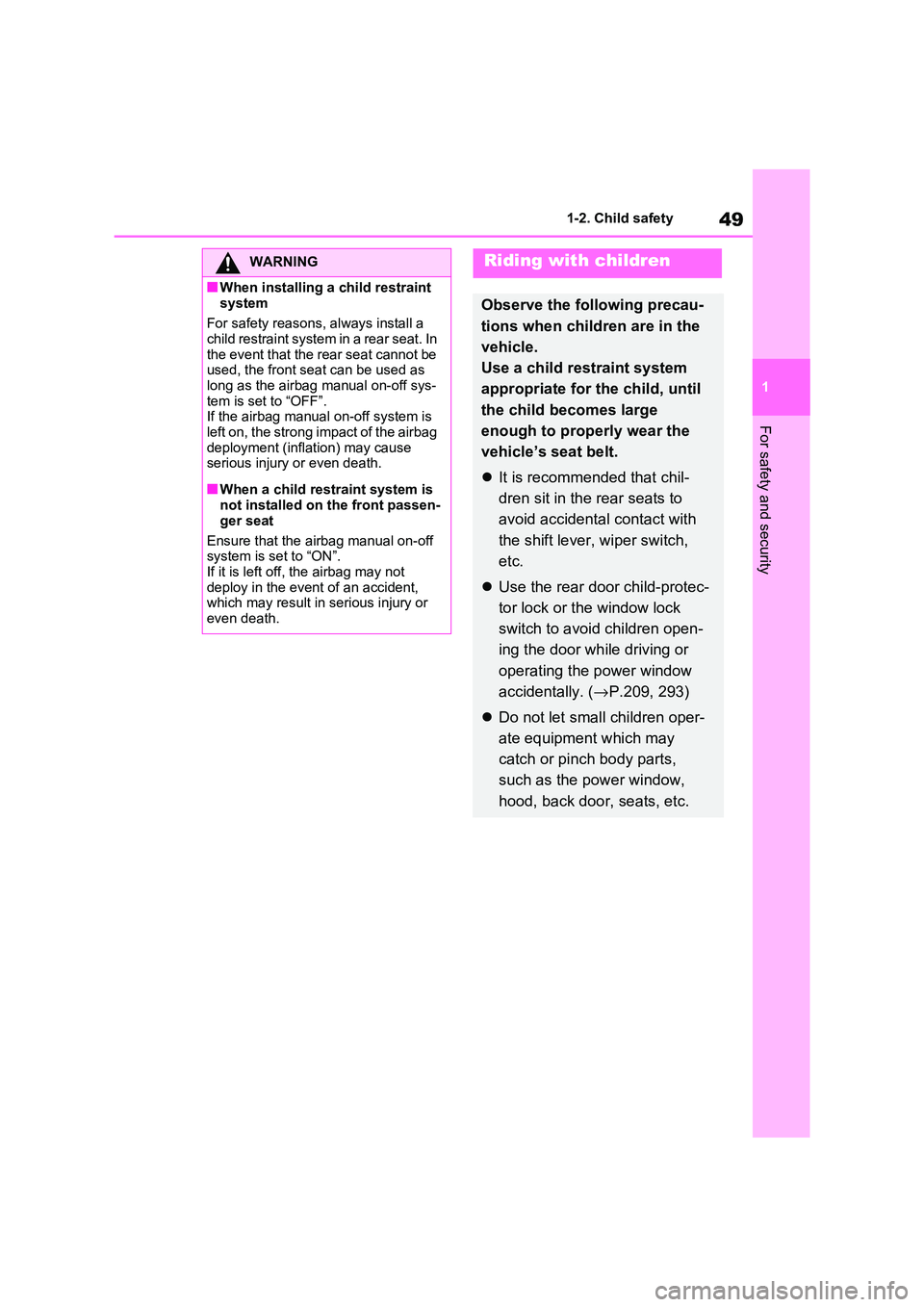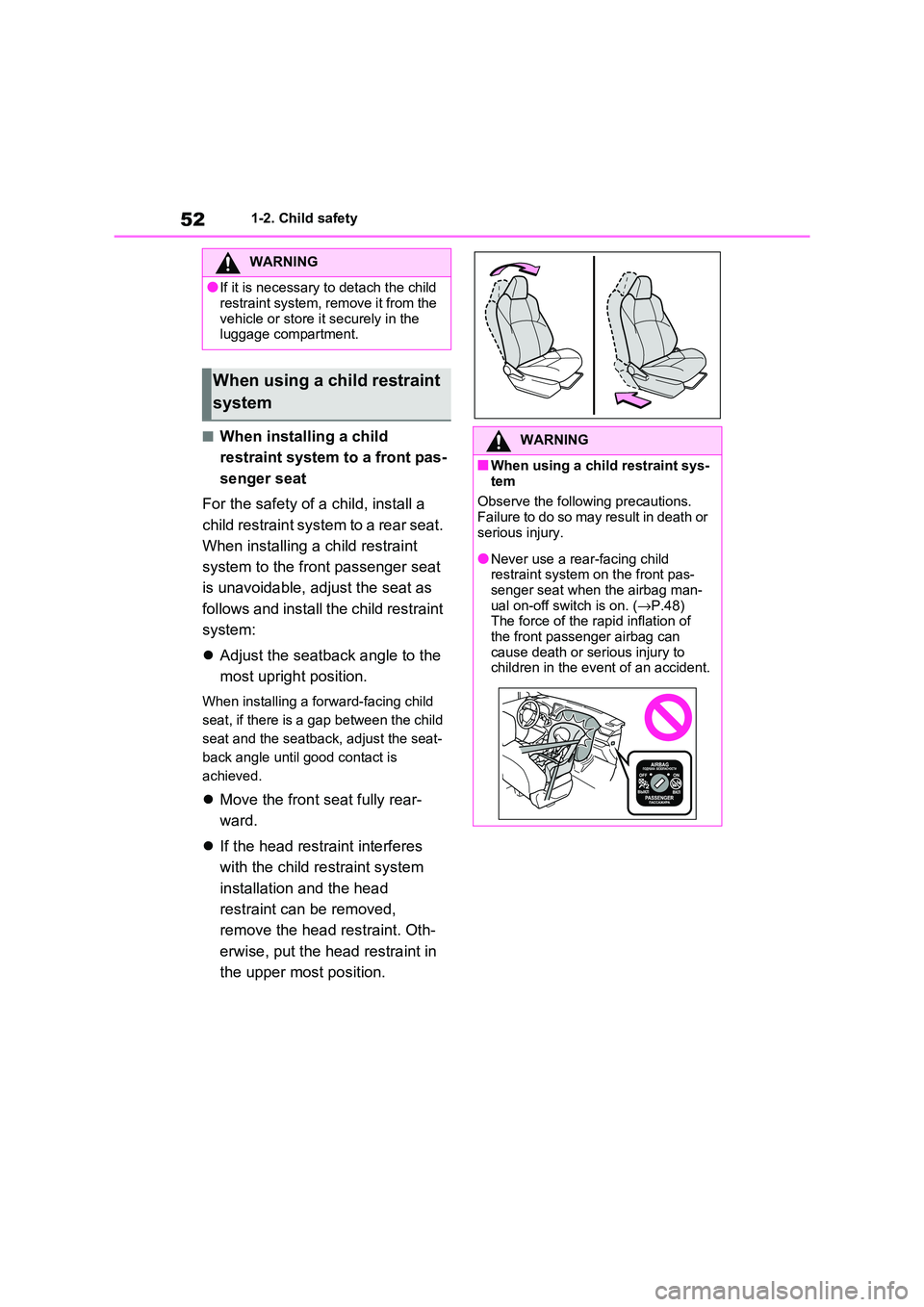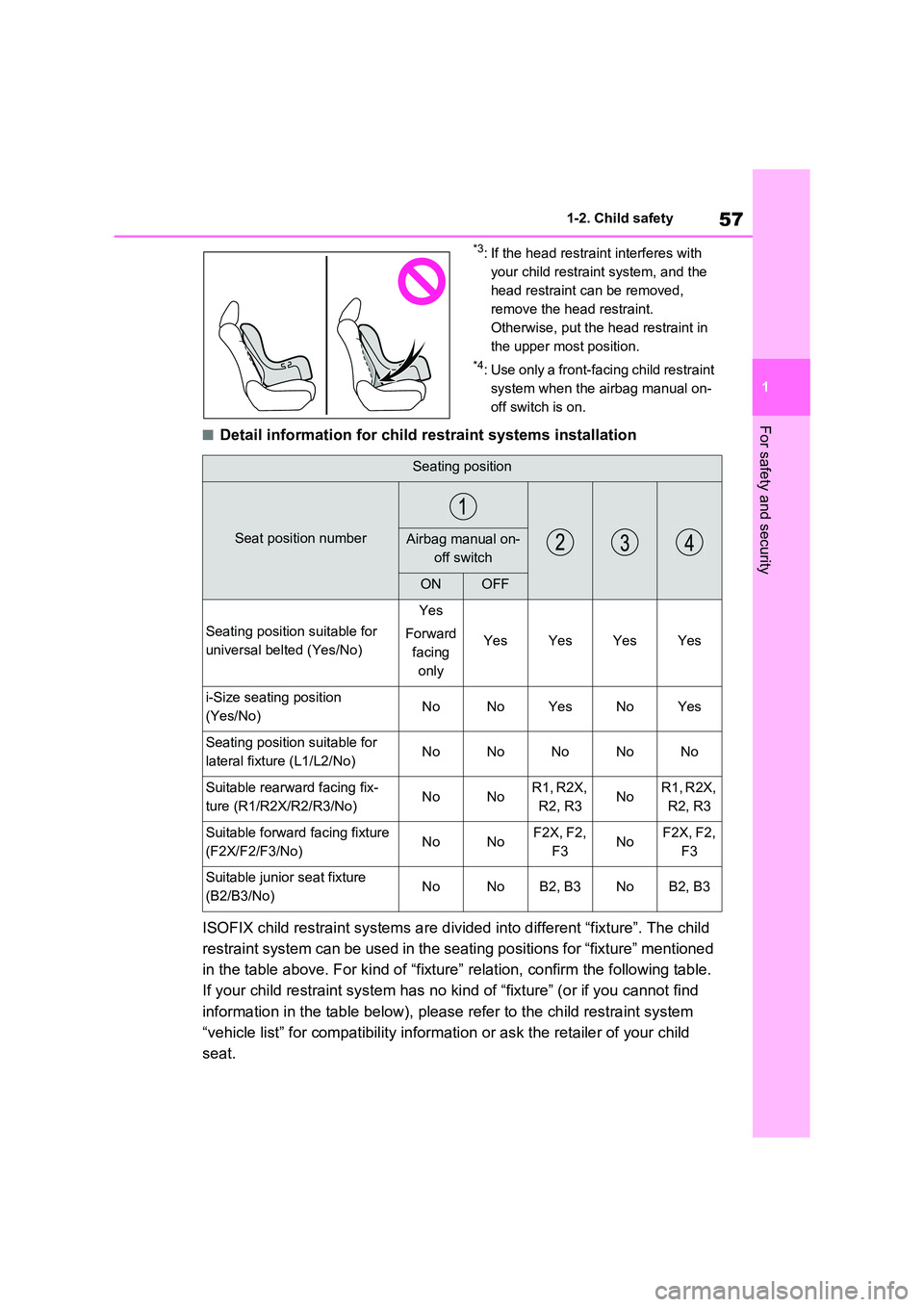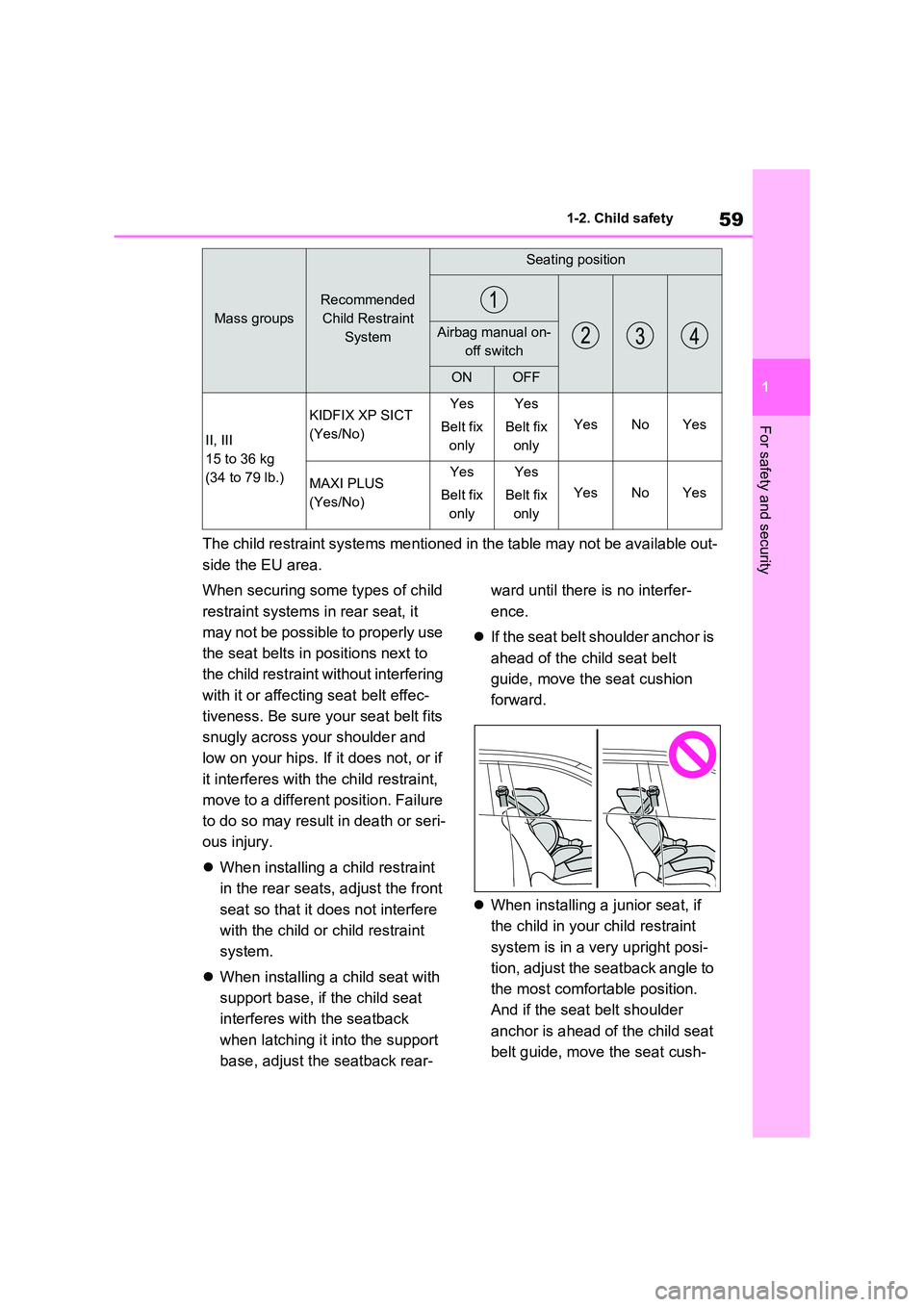2021 TOYOTA RAV4 PHEV airbag
[x] Cancel search: airbagPage 50 of 666

481-2. Child safety
1-2.Child safety
“PASSENGER AIR BAG” indi-
cator
“PASSENGER AIR BAG” and “ON”
indicator light turn on when the airbag
system is on, and about after 60 sec-
onds they go off ( only when the power
switch is in ON).
Airbag manual on-off switch
■“PASSENGER AIR BAG” indicator information
If any of the following problems occur, it
is possible that there is a malfunction in the system. Have the vehicle inspected
by any authorized Toyota retailer or
Toyota authorized repairer, or any reli - able repairer.
●The “OFF” indicato r does not illumi- nate when the air bag manual on-off
switch is set to “OFF”.
●The indicator light does not change
when the airbag manual on-off switch
is switched to “ON” or “OFF”.
Insert the mechanical key into the
cylinder and turn to the “OFF” posi -
tion.
The “OFF” indicator light turns on (only
when the power switch is in ON).
Airbag manual on-off
system
This system deactivates the
front passenger airbag.
Only deactivate the airbag
when using a child restraint
system on the front passenger
seat.
System components
A
B
Deactivating the airbags for
the front passenger
Page 51 of 666

49
1
1-2. Child safety
For safety and security
WARNING
■When installing a child restraint
system
For safety reasons , always install a child restraint system in a rear seat. In
the event that the rear seat cannot be
used, the front seat can be used as long as the airbag manual on-off sys-
tem is set to “OFF”.
If the airbag manual on-off system is
left on, the strong impact of the airbag deployment (inflation) may cause
serious injury or even death.
■When a child restr aint system is
not installed on the front passen -
ger seat
Ensure that the airbag manual on-off
system is set to “ON”.
If it is left off, the airbag may not deploy in the even t of an accident,
which may result in serious injury or
even death.
Riding with children
Observe the following precau -
tions when children are in the
vehicle.
Use a child restraint system
appropriate for the child, until
the child becomes large
enough to properly wear the
vehicle’s seat belt.
It is recommended that chil-
dren sit in the rear seats to
avoid accidental contact with
the shift lever, wiper switch,
etc.
Use the rear door child-protec-
tor lock or the window lock
switch to avoi d children open-
ing the door while driving or
operating the power window
accidentally. ( →P.209, 293)
Do not let small children oper-
ate equipment which may
catch or pinch body parts,
such as the power window,
hood, back door, seats, etc.
Page 54 of 666

521-2. Child safety
■When installing a child
restraint system to a front pas -
senger seat
For the safety of a child, install a
child restraint system to a rear seat.
When installing a child restraint
system to the front passenger seat
is unavoidable, adjust the seat as
follows and install the child restraint
system:
Adjust the seatback angle to the
most upright position.
When installing a forw ard-facing child
seat, if there is a gap between the child
seat and the seatback, adjust the seat -
back angle until good contact is
achieved.
Move the front seat fully rear-
ward.
If the head restraint interferes
with the child re straint system
installation and the head
restraint can be removed,
remove the head restraint. Oth -
erwise, put the head restraint in
the upper most position.
WARNING
●If it is necessary t o detach the child
restraint system, remove it from the
vehicle or store it securely in the luggage compartment.
When using a child restraint
system
WARNING
■When using a child restraint sys -
tem
Observe the following precautions. Failure to do so may result in death or
serious injury.
●Never use a rear-facing child restraint system on the front pas-
senger seat when the airbag man -
ual on-off switch is on. ( →P.48) The force of the rapid inflation of
the front passenger airbag can
cause death or serious injury to children in the eve nt of an accident.
Page 56 of 666

541-2. Child safety
■Child restraint system compat-
ibility for each seating posi -
tion
Compatibility of each seating posi -
tion with child re straint systems
( →P.56) displays the type of child
restraint systems that can be used
and possible seating positions for
installation using symbols. Also, the
recommended child restraint sys -
tem that is suitab le for your child
can be selected.
Otherwise, check [Recommended
child restraint systems and Com -
patibility table] for recommended
WARNING
●Only put a forward-facing child
restraint system o n the front seat
when unavoidable. When installing a forward-facing child restraint on
the front passenger seat, move the
seat as far back as possible. Failing to do so may result in death or seri -
ous injury if the airbags deploy
(inflate).
●Do not allow t he child to lean
his/her head or any part of his/her
body against the door or the area of the seat, front or rear pillars, or roof
side rails from which the SRS side
airbags or SRS curtain shield air - bags deploy even if the child is
seated in the child restraint system.
It is dangerous if the SRS side air - bags and curtain shield airbags
inflate, and the impact could cause
death or serious i njury to the child.
●When a junior seat is installed,
always ensure that the shoulder belt is positioned across the center
of the child’s shoulder. The belt
should be kept away from the child’s neck, but not so that it could
fall off the child’s shoulder.
●Use a child restraint system suit - able to the age and size of the child
and install it to the rear seat.
●If the driver’s sea t interferes with
the child restra int system and pre-
vents it from be ing attached cor- rectly, attach the child restraint
system to the right-hand rear seat
(left-hand drive vehicles) or the left- hand rear seat (right-hand drive
vehicles).
●Adjust the front passenger seat so
that it does not i nterfere with the
child restraint system.
Child restraint system com -
patibility for each seating
position
Page 59 of 666

57
1
1-2. Child safety
For safety and security
*3: If the head restraint interferes with
your child restrai nt system, and the
head restraint can be removed,
remove the head restraint.
Otherwise, put the head restraint in
the upper most position.
*4: Use only a front-facing child restraint
system when the airbag manual on-
off switch is on.
■Detail information for child r estraint systems installation
ISOFIX child restraint systems a re divided into different “fixture”. The child
restraint system can be used in the seating positions for “fixt ure” mentioned
in the table above. For kind of “ fixture” relation, confirm the following table.
If your child restraint system has no kind of “fixture” (or if you cannot find
information in the tab le below), please refer to the child restraint system
“vehicle list” for compatibilit y information or ask the retailer of your child
seat.
Seating position
Seat position numberAirbag manual on-
off switch
ONOFF
Seating position suitable for
universal belted (Yes/No)
Yes
Forward
facing
only
YesYesYesYes
i-Size seating position
(Yes/No)NoNoYesNoYes
Seating position suitable for
lateral fixture (L1/L2/No)NoNoNoNoNo
Suitable rearward facing fix -
ture (R1/R2X/R2/R3/No)NoNoR1, R2X,
R2, R3NoR1, R2X,
R2, R3
Suitable forward facing fixture
(F2X/F2/F3/No)NoNoF2X, F2,
F3NoF2X, F2,
F3
Suitable junior seat fixture
(B2/B3/No)NoNoB2, B3NoB2, B3
Page 60 of 666

581-2. Child safety
■Recommended child restraint systems and Compatibility table
FixtureDescription
F3Full-height, forward-facing child restraint systems
F2Reduced-height forward-facing child restraint systems
F2XReduced-height forward-facing child restraint systems
R3Full-size, rearward-facing child restraint systems
R2Reduced-size, rearward-facing child restraint systems
R2XReduced-size, rearward-facing child restraint systems
R1Rearward-facing infant seat
L1Left lateral-facing (carrycot) infant seat
L2Right lateral-facing (carrycot) infant seat
B2Junior seat
B3Junior seat
Mass groups
Recommended
Child Restraint
System
Seating position
Airbag manual on-
off switch
ONOFF
0, 0+
Up to 13 kg
(28 lb.)
G0+, BABY SAFE
PLUS (Yes/No)NoYesYesYesYes
G0+ BABY SAFE
PLUS with SEAT
BELT FIXATION,
BASE PLATFORM
(Yes/No)
NoYesYesYesYes
I
9 to 18 kg
(20 to 39 lb.)
TOYOTA DUO
PLUS (Yes/No)
Yes
Belt fix
only
Yes
Belt fix
only
Yes
Yes
Belt fix
only
Yes
Page 61 of 666

59
1
1-2. Child safety
For safety and security
The child restraint systems mentioned in the table may not be a vailable out-
side the EU area.
When securing some types of child
restraint systems in rear seat, it
may not be possible to properly use
the seat belts in positions next to
the child restraint without interfering
with it or affecti ng seat belt effec-
tiveness. Be sure you r seat belt fits
snugly across your shoulder and
low on your hips. If it does not, or if
it interferes with the child restraint,
move to a different position. Failure
to do so may result in death or seri -
ous injury.
When installing a child restraint
in the rear seats, adjust the front
seat so that it does not interfere
with the child or child restraint
system.
When installing a child seat with
support base, if the child seat
interferes with the seatback
when latching it into the support
base, adjust the seatback rear -
ward until there is no interfer -
ence.
If the seat belt shoulder anchor is
ahead of the child seat belt
guide, move the seat cushion
forward.
When installing a junior seat, if
the child in your child restraint
system is in a very upright posi -
tion, adjust the seatback angle to
the most comfortable position.
And if the seat belt shoulder
anchor is ahead of the child seat
belt guide, move the seat cush -
II, III
15 to 36 kg
(34 to 79 lb.)
KIDFIX XP SICT
(Yes/No)
Yes
Belt fix
only
Yes
Belt fix
only
YesNoYes
MAXI PLUS
(Yes/No)
Yes
Belt fix
only
Yes
Belt fix
only
YesNoYes
Mass groups
Recommended
Child Restraint
System
Seating position
Airbag manual on-
off switch
ONOFF
Page 67 of 666

65
1
1-3. Emergency assistance
For safety and security
1-3.Emergency assistance
*: Operates within the eCall coverage.
The system name differs depending
on the country.
Type A
“SOS” button*
Indicator lights
Microphone
Speaker
*: This button is intended for communi -
cation with the eCal l system operator.
Other SOS buttons available in other
systems of a motor vehicle do not
relate to the dev ice and are not
intended for communication with the
eCall system operator.
Type B
“SOS” button*
Indicator lights
Microphone
Speaker
*: This button is intended for communi -
cation with the eCal l system operator.
Other SOS buttons available in other
systems of a motor vehicle do not
relate to the dev ice and are not
intended for communication with the
eCall system operator.
■Automatic Emergency Calls
If any airbag deploys, the system is
designed to automatically call the
eCall control center.* The answer -
ing operator receives the vehicle’s
eCall*
eCall is a telematics service
that uses Global Navigation
Satellite System (GNSS) data
and embedded cellular tech -
nology to enable the following
emergency calls to be made:
Automatic emergency calls
(Automatic Collision Notifica -
tion) and manual emergency
calls (by pressing the “SOS”
button). This service is
required by European Union
Regulations.
System components
A
B
C
Emergency Notification Ser -
vices
D
A
B
C
D